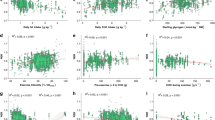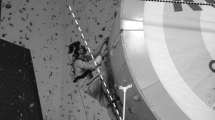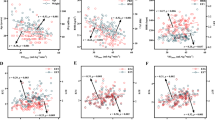Summary
This study examined the effects of dietary manipulation upon the respiratory exchange ratio (\(R = \dot V_{{\text{CO}}_{\text{2}} } /\dot V_{{\text{O}}_{\text{2}} } \)) as a predictor of maximum oxygen uptake (\(\dot V_{{\text{O}}_{{\text{2}} {\text{max}}} } \)). Seven healthy males performed fixed term maximal incremental treadmill exercise after an overnight fast on three separate occasions. The first test took place after the subjects had consumed their normal mixed diet (45±5% carbohydrate (CHO)) for a period of three days. This test protocol was then repeated after three days of a low CHO diet (3±2% CHO), and again after three days of a high CHO diet (61±5% CHO). Respiratory gases were continuously monitored during each test using an online system. No significant changes in mean exercise oxygen uptake (\(\dot V_{{\text{O}}_{\text{2}} } \)),\(\dot V_{{\text{O}}_{{\text{2}} {\text{max}}} } \) or maximum functional heart rate (FHRmax) were found between tests. Mean exercise carbon dioxide output (\(\dot V_{{\text{CO}}_{\text{2}} } \)) and R were significantly lower than normal after the low CHO diet (bothp<0.001) and significantly higher than normal after the high CHO diet (bothp<0.05). Moreover, compared with the normal CHO diet, the R-time relationship during exercise was at all times significantly (p<0.001) shifted to the right after the low CHO diet, and shifted to the left, being significantly so (p<0.05) over the final 5 min of exercise, after the high CHO diet. As a result, predictions of\(\dot V_{{\text{O}}_{{\text{2}} {\text{max}}} } \) based on the R-time relationship were similar to recorded\(\dot V_{{\text{O}}_{{\text{2}} {\text{max}}} } \) after the normal CHO dietary condition (-1.5±1.9%), but higher after the low CHO diet (+14.8±3.9%,p<0.001) and lower after the high CHO diet (−7.0±4.5%,p<0.01). These results indicate that dietary manipulation can significantly affect respiratory gas exchanges during fixed term maximal incremental exercise, and by doing so can significantly influence predictions of\(\dot V_{{\text{O}}_{{\text{2}} {\text{max}}} } \) based on R.
Similar content being viewed by others
References
Aitken JC, Thompson J (1988a) The respiratory\(\dot V_{{\text{CO}}_{\text{2}} } /\dot V_{{\text{O}}_{\text{2}} } \) exchange ratio during maximum exercise and its use as a predictor of maximum oxygen uptake. Eur J Appl Physiol 57:714–719
Aitken JC, Thompson J (1988b) The effects of previous severe exercise upon the respiratory\(\dot V_{{\text{CO}}_{\text{2}} } /\dot V_{{\text{O}}_{\text{2}} } \) exchange ratio as a predictor of maximum oxygen uptake. Eur J Appl Physiol 57:720–725
Aitken JC, Thompson J (1987) The effect of acidosis and alkalosis on the respiratory exchange ratio during maximal incremental treadmill exercise in man. J Physiol 392:102P
Buchführer MJ, Hansen JE, Robinson TE, Sue DY, Wasserman K, Whipp BJ (1983) Optimizing the exercise protocol for cardiopulmonary assessment. J Appl Physiol 55:1558–1564
Greenhaff PL, Gleeson M, Maughan RJ (1988) The effects of a glycogen loading regimen on acid-base status and blood lactate concentration before and after a fixed period of high intensity exercise in man. Eur J Appl Physiol 57:254–259
Hughson RL, Kowalchuk JM (1981) Influence of diet on CO2 production and ventilation in constant-load exercise. Respirat Physiol 46:149–160
Hultman E (1967) Physiological role of muscle glycogen in man with special reference to exercise. Circ Res [Suppl 1] 20–21:99–111
Jansson E, Kaijser L (1982) Effect of diet on utilisation of blood-borne and intramuscular substrates during exercise in man. Acta Physiol Scand 115:19–30
Kelman GR, Maughan RJ, Williams C (1975) The effect of dietary modifications on blood lactate during exercise. J Physiol 251:34–35
Kowalchuk JM, Heigenhauser GJF, Jones NL (1984) Effect of pH on metabolic and cardiorespiratory responses during progressive exercise. J Appl Physiol 57:1558–1563
Maughan RJ, Williams C, Campbell DM, Hepburn D (1978) Fat and carbohydrate metabolism during low intensity exercise: Effects of the availability of muscle glycogen. Eur J Appl Physiol 39:7–16
McCance RA, Widdowson ED (1960) The composition of foods. MRC Special, Report Series No 297, London, HMSO
Paul A, Southgate D (1978) The composition of foods. 4th Edition, London, HMSO
Quirion A, Brisson GR, Laurencelle L, DeCarufel, Audet A, Dulac S, Ledoux M, Vogelaere P (1988) Lactate threshold and onset of blood lactate accumulation during incremental exercise after dietary modifications. Eur J Appl Physiol 57:192–197
Richter EA, Galbo H (1986) High glycogen levels enhance glycogen breakdown in isolated contracting skeletal muscle. J Appl Physiol 61:827–831
Sutton JR, Jones NL, Toews CJ (1981) Effects of pH on muscle glycolysis during exercise. Clin Sci 61:331–338
Thompson J, Brice JEH, Kurdy NMG, Walker CHM (1979) A modified open circuit method for the estimation of oxygen consumption and carbon dioxide excretion in adults, infants and small animals. Pflügers Arch 380:197–202
Yoshida T (1984) Effect of dietary modifications on lactate threshold and onset of blood lactate accumulation during incremental exercise. Eur J Appl Physiol 53:200–205
Author information
Authors and Affiliations
Rights and permissions
About this article
Cite this article
Aitken, J.C., Thompson, J. The effects of dietary manipulation upon the respiratory exchange ratio as a predictor of maximum oxygen uptake during fixed term maximal incremental exercise in man. Europ. J. Appl. Physiol. 58, 722–727 (1989). https://doi.org/10.1007/BF00637383
Accepted:
Issue Date:
DOI: https://doi.org/10.1007/BF00637383




